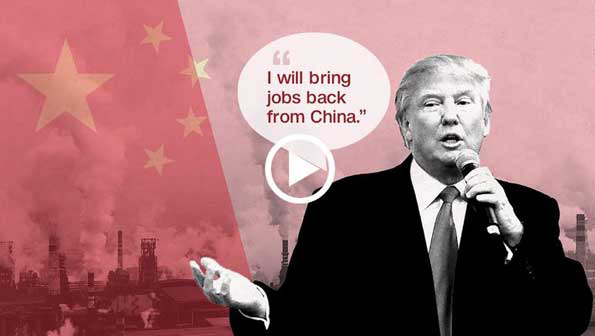Trade frictions are nothing new to the U.S.-China relationship. Over the years they’ve ebbed and flowed, but were managed with enough deft to avoid major meltdowns. That seems likely to change under President Donald Trump, an economic nationalist who sees trade as a zero-sum game and the United States emerging “the winner” of a trade war with China.

Since China runs a large bilateral trade surplus with the United States, Trump believes the United States has enormous leverage to compel changes in China’s behavior by threatening and imposing trade restrictions. Trump has support for this provocative tack – a “mandate to blow things up,” as it’s been described – but it would constitute a major departure from over 80 years of U.S. trade policy orthodoxy. It could also devastate the global economy.
Ever since the George H.W. Bush administration chose engagement with China – instead of containment – in the aftermath of the Tiananmen Square massacre in 1989, U.S. policy has been an exercise in balancing two broad sets of interests.
On one side have been import-competing U.S. industries and organized labor, which sought to impede Chinese exporters’ penetration of the U.S. market. They demanded tariffs, quotas, and other policies to redress their concerns about objectionable Chinese practices, such as dumping, subsidization, currency manipulation, intellectual property theft, forced technology transfer, and labor and environmental abuses.
On the other side have been U.S. multinational companies and exporters, which favored a more cautious and less antagonistic approach. They have preferred the idea of accommodating China as it fumbled its way forward in the process of joining and integrating with the global economy. These groups counselled against policies and actions that could jeopardize U.S. access to the Chinese market. Trade with China, they argued, also served the interests of U.S. import-using industries and consumers.
U.S. policy generally split the difference between these perspectives: China would be welcomed into the community of nations and its companies and products would be treated on par with all other nations’. But U.S. industries would have recourse to trade remedy laws and special China-specific safeguards, and the U.S. government would be able to bring complaints, when necessary, to the World Trade Organization. And various bilateral dialogues would be instituted to discuss and resolve issues that would inevitably arise, as the relationship evolved.
By and large, this formula worked reasonably well to distill the economic benefits, while ensuring the frictions never ignited a blaze. But things started to change in 2009.
As the U.S. economy was mired in a deep recession, the Chinese economy was continuing its near-double-digit annualized rate of growth, surpassing the United States as the world’s largest manufacturer and exporter, and edging closer to becoming the world’s largest economy. U.S. pundits and policymakers began to ask whether America’s best days were behind her. Many wondered where the United States had gone wrong, and what China had done right. Some suggested that the United States should emulate China’s industrial policies. Others lamented America’s acquiescence to China’s rise, and demanded more rigorous enforcement of trade rules.
Meanwhile, the traditionally pro-engagement U.S. business community in China began to air pent-up grievances about proliferating discrimination in China. A study published by the American Chamber of Commerce in China identified rising protectionism, lack of regulatory transparency, inconsistent application of rules, and favoritism toward local firms as big and growing problems, while a separate report from the same organization exposed “a web of industrial policies,” as well as Chinese government plans to build national champions by “borrowing” Western technology.
Publication of those reports and reaction to them ultimately softened enthusiasm among U.S. multinationals for making the case for an accommodating, tolerant U.S. policy. That prompted a shift to a more contentious U.S. policy.
At the outset of his tenure, President Obama authorized tariffs on Chinese tires under a provision of U.S. law, which President Bush had refused to invoke. That action prompted a WTO challenge from China (which it lost), as well as a slew of “retaliatory” trade remedy actions against U.S. products, including chicken and automobiles.
Application of the U.S. countervailing duty (anti-subsidy) law to so-called “non-market” economies (i.e., China and Vietnam) was explicitly authorized by the administration, and U.S. industries filed a record number of unfair trade cases against China during the Obama presidency. The number of U.S. complaints against China in the WTO increase by five-fold. Chinese acquisitions of U.S. companies were subject to greater scrutiny than in the past, with some transactions being blocked and others undone through forced divestment. With the Obama administration’s support, Congress took the extraordinary measure of barring U.S. government agency purchases and use of Chinese telecommunications products.
Meanwhile, the Chinese government didn’t sit still. Under President Hu and then President Xi a slew of new laws were implemented, affecting – among other things – foreign investment, competition policy, and cybersecurity. Reports of U.S. companies being harassed, subjected to onerous documentation requirements, denied business opportunities, and compelled to turn over trade secrets and encryption keys became commonplace.
Continued failure of the two governments to reach agreement over a prospective bilateral investment treaty – as well impasses in other negotiations – reinforced conclusions that cooperation was becoming too difficult.
As 2016 began, the anti-trade rhetoric common during election years was more acerbic than usual. Chinese trade policies were under attack from both ends and across the political spectrum. Publication of an explosive academic article, which was perceived to indict Chinese trade practices as a cause of massive U.S. labor market disruption, galvanized public opinion behind calls for a more combative approach to China’s trade policies.
The Obama administration filed four new complaints against China in the WTO and the Commerce Department initiated 24 new antidumping and countervailing cases against Chinese exporters. China remained active with its own trade remedies, and filed a WTO complaint against the United States on December 12 for its failure to grant China “market economy” status, which was something it was to have done by no later than 15 years after China’s accession to the WTO.
Despite all of the trade disputes and growing bilateral tensions, the relationship did not go over the edge during the Obama presidency. But with a new president, who speaks of winning trade wars, and a Chinese government that promises not to back down, going over the edge and into the abyss seem only a matter of time.
Trump has threatened to unilaterally impose a 45 percent across-the-board tariff on imports from China to redress alleged currency manipulation, which is an absurdly outdated complaint. The Chinese have not intervened in currency markets to suppress the value of the Yuan for over a decade and, in recent years, have been struggling to prop up its value in the face of rampant capital flight.
But there are plenty of other frictions that could become catalysts. Discrimination against U.S. businesses in China; favoritism toward Chinese state-owned enterprises; massive subsidization of industries; intellectual property theft; cyberespionage; deeper U.S. scrutiny of Chinese acquisitions in the United States; U.S. discrimination against Chinese telecommunications companies; and U.S. refusal to treat China as a market economy all remain prominent points of contention in the relationship.
Like a slow motion train wreck, we can see what’s coming, but are powerless to stop it. No longer do facts matter. No longer is there appetite for cautious deliberation. No longer can we assume cooler heads will prevail. The guardrails and emergency brakes that prevented the relationship from running off the tracks in the past have fallen into disrepair. Where else to go, but into the abyss?



